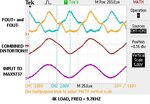MarkCSI
Newbie level 4
- Joined
- Feb 4, 2013
- Messages
- 5
- Helped
- 0
- Reputation
- 0
- Reaction score
- 0
- Trophy points
- 1,281
- Location
- Chatsworth
- Activity points
- 1,319
Hi,
I am trying to use a Class D Amp to drive a non-audio application (360 - 12000Hz, load will vary), and am getting distortion on the output when no load or lighter load is present. The basic flow is:
Class D Amp -> LPF -> Step Up Xfmr -> Output
I am using the LPF in the Eval kit (Max9737). The LPF is designed for an 8Ω load.
What I am seeing is not the high freq switching distortion, but much lower. I have included a scope trace . BTW, it happens with or without the XFMR. The FAE said it is because ther LPF is tuned for 8Ω.
. BTW, it happens with or without the XFMR. The FAE said it is because ther LPF is tuned for 8Ω.
I have a few questions:
1. Does this make sense to anybody
2. He sais I should simulate the LPF to optimize. How does one create the class d signal for simulation?
3. Does anybody have a recommendation for a free/cheap simulator?
Thanks!
Mark
I am trying to use a Class D Amp to drive a non-audio application (360 - 12000Hz, load will vary), and am getting distortion on the output when no load or lighter load is present. The basic flow is:
Class D Amp -> LPF -> Step Up Xfmr -> Output
I am using the LPF in the Eval kit (Max9737). The LPF is designed for an 8Ω load.
What I am seeing is not the high freq switching distortion, but much lower. I have included a scope trace
 . BTW, it happens with or without the XFMR. The FAE said it is because ther LPF is tuned for 8Ω.
. BTW, it happens with or without the XFMR. The FAE said it is because ther LPF is tuned for 8Ω.I have a few questions:
1. Does this make sense to anybody
2. He sais I should simulate the LPF to optimize. How does one create the class d signal for simulation?
3. Does anybody have a recommendation for a free/cheap simulator?
Thanks!
Mark